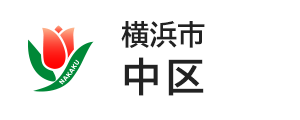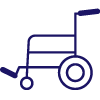- 橫濱市首頁
- 中區首頁
- 各種各樣的語言(Multilingual)
- English
- Public Relations Magazines
- Koho Yokohama Naka Ward Version(~2023)
- 2022
- February ①Do you have a fire alarm system installed in your home? ②Yokohama Chinatown ③A Little Helping Hand (3)
從這裡開始是正文
February ①Do you have a fire alarm system installed in your home? ②Yokohama Chinatown ③A Little Helping Hand (3)
This is an abridged version of “Koho Yokohama Naka-ku Ban,” Naka Ward Office’s public relations magazine. (Click here for the multilingual website of “Koho Yokohama City Edition”)
Last updated date:2024/10/9
① Do you have a fire alarm system installed in your home?
[Inquiries] Sōmu/Yobō-ka, Yobō Tantō (Fire Prevention Section,
General Affairs/Fire Prevention Division),
Naka Fire Station Tel/Fax: 045-251-0119
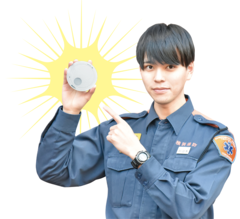
The main cause of death in house fires is failure to escape in time.
Fire alarms are required by law to be installed in all homes. They automatically detect smoke and heat generated by a fire and alert you with a sound or alarm. If you haven’t installed one yet, please do so as soon as possible to save your life and that of your family in the event of a fire!

The lifespan of these devices is 10 years!
To ensure that they function properly in times of emergency, residential fire alarms should be replaced every 10 years or so.
I’m so glad I’d installed a fire alarm! Actual incidents that happened here in Yokohama

The remaining sparks from a cigarette butt in an ashtray continued to smolder and caught fire. It ignited some nearby garbage, filling the room with smoke and setting off the alarm.
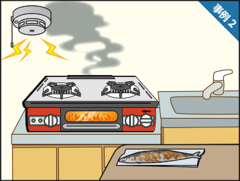
After cooking fish on the grill, this person forgot to turn off the flame. The oil in the grill burned, causing smoke and setting off the alarm.

Someone was heating up some fried food in a toaster oven and went off to do something. Smoke came out of the toaster and the alarm went off.
Residential fire alarm Q&A
Q What are the different types of residential fire alarms?
A There are two types: smoke alarms, <photoelectric type> (installed in bedrooms, stairwells, kitchens, etc.) and heat alarms <thermostatic type> (installed in kitchens, garages, etc.).

Q Where can I buy one?
A They are sold at electronics stores and home centers.
When purchasing a fire alarm, please make sure to buy one with this mark.
Q Where should I install fire alarms?
A In the kitchen and bedrooms. If bedrooms are on the second floor or higher, you will also need to install one on the stairs.
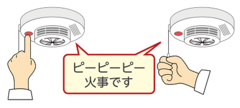
Q How do I check that my fire alarms are working properly?
A You should regularly check fire alarms to make sure that they are working properly. For details on how to check fire alarms, please refer to the instruction manual for the device in question beforehand.
② My town’ s shopping streets: Yokohama Chinatown
[Inquiries] Chiiki Katsudō Tantō (Community Activities Section),
Naka Ward Office Tel: 045-224-8132 Fax: 045-224-8215

There are many unique shopping streets in Naka Ward. This month, we will introduce Yokohama Chinatown, one of the most popular tourist spots in Yokohama. Learn more about Chinatown, a shopping district with a history of more than 150 years since the opening of the port, and discover something new about this fascinating area of town!
Tell me about it! History and attractions of Chinatown
Yokohama Chinatown is home to about 620 stores in total, including restaurants and general stores! With so many stores here, we asked representatives of two shopping associations and the Yokohama Chukagai Hattenkai Kyodo Kumiai (Yokohama Chinatown Development Association Cooperative) to tell us about the charms of Chinatown.
Yokohama Chukagai Ichiba-dori Kai

Mr. Takaya Terukazu, chairman
The name Ichiba-dori (Market Street) comes from the fact that, from around 1921, the street was lined with a variety of stores, including butchers, fishmongers, specialty shrimp stores, fruit and vegetable stores, dry goods stores, and tableware stores. These stores served Chinese restaurants and local residents and were open only in the mornings, and people therefore called it a morning market. As time went by, the general stores withdrew and Chinese restaurants increased in number, becoming the area of town you see today.
In addition to the four major Chinese cuisines of Beijing, Shanghai, Cantonese, and Sichuan, Taiwanese restaurants are also located here.

Chukagai Kanteibyo-dori Kai

Ms. Soki Ma, chairman
This is one of the oldest shopping streets in Yokohama Chinatown, with a long history going back many years. Here, you can immerse yourself in the history of not only Chinatown but also Naka Ward as a whole, as there are monuments to the birthplace of newspapers and the birthplace of rugby, not to mention the popular Chinatown sightseeing spot, Kanteibyo.
In addition to restaurants, here you will find various stores including tea stores, hardware stores selling woks and other items, florists, barber shops, electronics stores, and food stores.
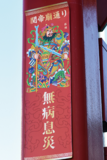
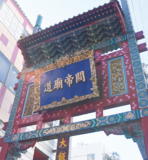
Yokohama Chukagai Hattenkai Kyodo Kumiai

Mr. Nobumasa Takahashi, Chairman of the Board
There are many Chinatowns in various countries, but only the Chinatown in Naka Ward is visited by so many people from their own country. Our brand vision is “Yokohama Chinatown, a town full of repeat visitors.” To achieve this goal, we are working together to ensure the safety and security of the community. I hope that Naka Ward residents will visit Chinatown many times and find five or six favorite restaurants that they can use for different occasions.
The corners of the area occupied by Chinatown are located in the north, south, east, and west directions, which fits in well with the urban planning of Chinatown based on the Feng Shui concept. The Choyomon, Suzakumon, Enpeimon, and Genbumon gates, which guard the north, south, east, and west sides of the city, are painted in blue, red, black, and white according to the Feng Shui concept. In addition to these four gates, there are ten other gates with elaborate designs in Chinatown. Please stop and take your time to look up at them.
This Chinese New Year, for the first time, objet d’art lanterns will be displayed outside Chinatown, and there will be a stamp rally to coincide with this. It will be a great opportunity to discover stores you didn’t know existed, rediscover the charm of places you know, and get to know the area better. And I’m sure you’ll come to love Yokohama even more!

For more information onChinese NewYear and apps,訪問the Beach Chinatown網站(外部網站)(in Japanese).
Information
Now streaming: PR video of attractive shopping streets!
There are many shopping streets in Naka Ward that are doing their very best to cope during the COVID-19 pandemic. Check out the charm of the shopping streets in this video (in Japanese).
Let’s walk around Chinatown with a smartphone!
The Chinatown Shopping Street Mission is scheduled to be held in March!
If you complete a set number of steps with the Yokohama Walking Point pedometer app, you will receive a coupon that can be used at various stores. For more information,請訪問the網站(外部網站)(in Japanese).
③ Multicultural Community Column: A Little Helping Hand (3)
[Inquiries] Kikaku Chōsei-kakari (Planning and Adjustment Section),
Naka Ward Office Tel: 045-224-8127 Fax: 045-224-8214
Disaster preparedness
Japan is an earthquake-prone country. There must be many non-Japanese residents who experienced an earthquake for the first time after coming to Japan. In times of emergency, everyone needs to stick together and have a spirit of mutual help, both Japanese and non-Japanese residents alike.

[Lisa, a junior high school student from the U.S.]
The other day, my house suddenly shook, and I was so surprised!

[Mr. Negishi, a neighbor (who likes to take care of people]
If your house is damaged by a big earthquake and you can no longer live there, do you know where you can take shelter?
The elementary and junior high schools near my house are such places. They’re called “evacuation shelters.”

Where is the nearest evacuation shelter to my home?

You can check the “NAKA-KU Ward Resident Life Activity Map” or the “Naka Ward Regional Disaster Management Base” booklets. Once an evacuation shelter is opened up, evacuees work together to distribute food, set up toilets, and manage the shelter.

By the way, my friend’s family was having trouble knowing what to do in the event of a major disaster...

If that’s the case, please tell them about the booklet “Disaster Prevention in Japan.” It contains information on how to prepare for everyday life, how to check on the safety of your loved ones, as well as multilingual information support sites in case of a disaster.
Foreign language versions of the booklets “Naka Ward Regional Disaster Management Base” and “Disaster Prevention in Japan” are now available, so make sure to tell your friends about them!
頁面ID:760-549-899
